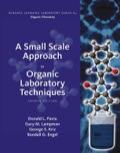
(a)
Interpretation:
The method of correcting the following error in the TLC chromatography procedure needs to be explained.
There is only one spot obtained from a mixture of two components namely 1-octene and 1,4-dimethylbenzene with retention factor 0.95 in the presence of acetone as a solvent.
Concept Introduction:
The method of separation of components of the mixture is done by column chromatography techniques. This method is used to isolate the large number of components. The movement of solvent molecules in the thin layer chromatography takes place from bottom to top but in the column chromatography, the movement of mobile phase takes place from top to bottom in the column.
(b)
Interpretation:
The method of correcting the following error in the TLC chromatography procedure needs to be explained.
There is only one spot obtained from a mixture of two components namely dicarboxylic acid and tricarboxylic acid with retention factor 0.05 in the presence of hexane as a solvent.
Concept Introduction:
The method of separation of components of the mixture is done by column chromatography techniques. This method is used to isolate the large number of components. The movement of solvent molecules in the thin layer chromatography takes place from bottom to top but in the column chromatography, the movement of mobile phase takes place from top to bottom in the column.
(c)
Interpretation:
The method of correcting the following error in the TLC chromatography procedure needs to be explained.
In the developed TLC plate, the solvent front ran off the top of the plate.
Concept Introduction:
The method of separation of components of the mixture is done by column chromatography techniques. This method is used to isolate the large number of components. The movement of solvent molecules in the thin layer chromatography takes place from bottom to top but in the column chromatography, the movement of mobile phase takes place from top to bottom in the column.
Want to see the full answer?
Check out a sample textbook solution
Chapter 5 Solutions
EBK A SMALL SCALE APPROACH TO ORGANIC L
- 6.15PM Sun Mar 30 K Draw the major product of this reaction. Include any relevant stereochemistry. Ignore inorganic byproducts. Problem 1 of O H [PhзPCH2CH3]*C|¯ NaH Drawing > Q Atoms, Bonds and Draw or tap a nearrow_forward8:17 PM Sun Mar 30 Draw the major product of this reaction. Ignore inorganic byproducts. HSCH2CH2CH2SH, BF3 Probler Drawing Ato Bonds Clarrow_forwardpresented by Mr L How the coprion. (Il Done in no wraction, dew the starting redential) доarrow_forward
- 8:16 PM Sun Mar 30 K Draw the major product of this reaction. Ignore inorganic byproducts. Proble 1. CH3MgBr 2. H3O+ F Drawingarrow_forwardо но оarrow_forwardName the major organic product of the following action of 4-chloro-4-methyl-1-pentanol in neutral pollution 10+ Now the product. The product has a molecular formula f b. In a singly hain, the starting, material again converts into a secule with the molecular kormula CIO. but with comply Draw the major organic structure inhalationarrow_forward
- Macmillan Learning Alcohols can be oxidized by chromic acid derivatives. One such reagent is pyridinium chlorochromate, (C,H,NH*)(CICTO3), commonly known as PCC. Draw the proposed (neutral) intermediate and the organic product in the oxidation of 1-butanol by PCC when carried out in an anhydrous solvent such as CH₂C₁₂. PCC Intermediate OH CH2Cl2 Draw the intermediate. Select Draw Templates More с H Cr о Product Draw the product. Erase Select Draw Templates More H о Erasearrow_forwardIf I have 1-bromopropene, to obtain compound A, I have to add NaOH and another compound. Indicate which compound that would be. A C6H5 CH3arrow_forwardProvide the reagents for the following reactions.arrow_forward
- If I have 1-bromopropene, to obtain compound Z, I have to add two compounds A1 and A2. Indicate which compounds are needed. P(C6H5)3arrow_forwardDraw the major product of this reaction. Ignore inorganic byproducts. Assume that the water side product is continuously removed to drive the reaction toward products. O CH3CH2NH2, TSOH Select to Draw >arrow_forwardPredict the major organic product(s) for the following reaction.arrow_forward
 EBK A SMALL SCALE APPROACH TO ORGANIC LChemistryISBN:9781305446021Author:LampmanPublisher:CENGAGE LEARNING - CONSIGNMENT
EBK A SMALL SCALE APPROACH TO ORGANIC LChemistryISBN:9781305446021Author:LampmanPublisher:CENGAGE LEARNING - CONSIGNMENT
